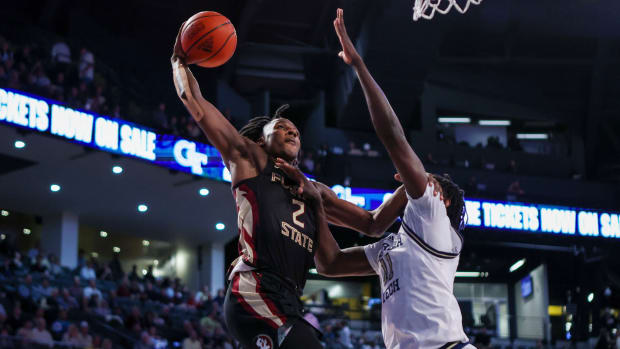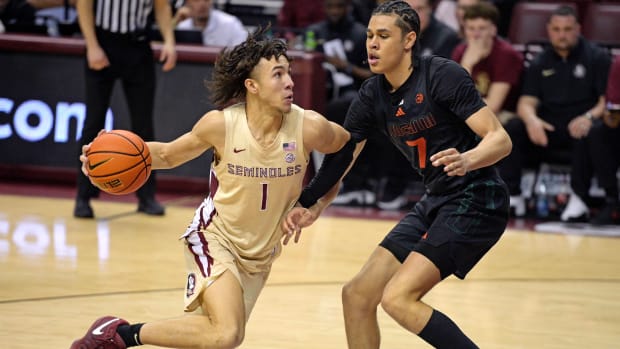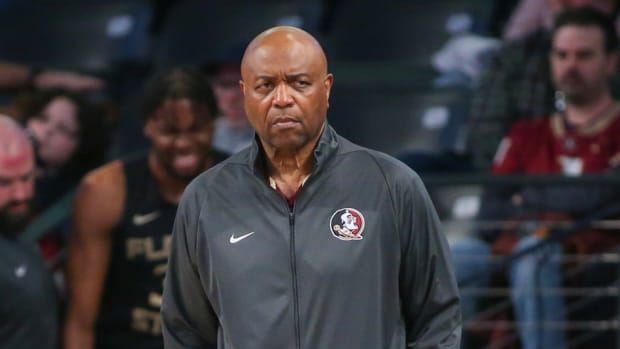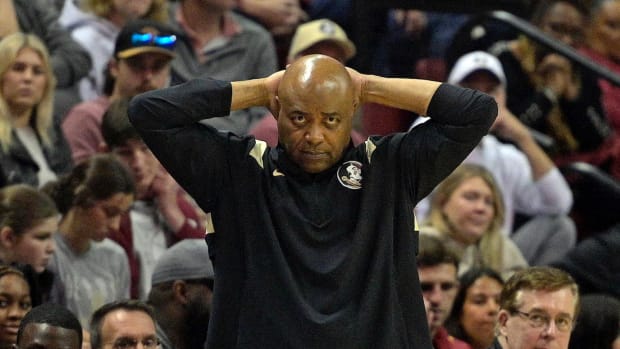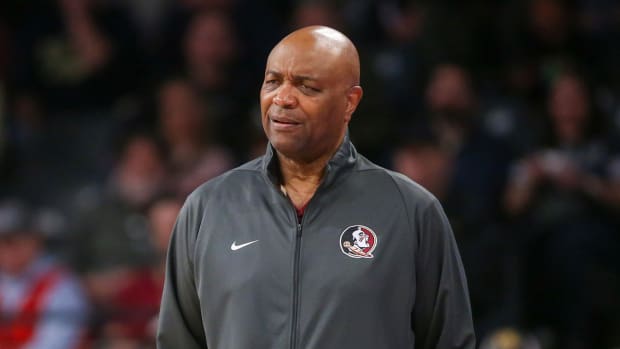FSU's Top Road Victories: Florida, 1993
The sound was so loud that I considered sitting down on the bleachers, below the cheering, and covering my ears. Instead, I resolved to stand there and accept it. If we were going to lose because Jack Jackson had made a miraculous catch in the front corner of the North End Zone, then I was going to take it.
I was nine years old, and my dad had driven me and my brother up to the game in Gainesville. FSU was the No. 1 team in the land, even after suffering a lose to Notre Dame. The Gators were the country's No. 7 team and looking to spoil their rivals' chance at their first national title. The 'Noles wanted to be the first team to beat UF in the Swamp since 1989 and move on to a New Year's Bowl with the future Heisman Trophy winner, Charlie Ward.
We parked our garnet and gold Eddie Bower Edition Ford Aerostar near Shands Hospital. It was a 90-minute drive from our home in Citrus County, a former agriculture town now dominated by retirement communities and former farmers who had never stepped foot on the University of Florida's campus but swore allegiance every time they put on jean shorts.
The early 90s were a gloriously confused time for team apparel. Nike was making a foray into the college game, but licenses were handed out to anyone from Logo Athletic to Reebok and Starter. This game had the most classic FSU uniforms on the field. The sideline gear hadn't quite figured out if it wanted to be the bulky, classic university wear that was made popular in cooler climates, or the sleek athletic look that placed function over form.
The game was close in the first half. Tamarick Vanover scored the only touchdown for the 'Noles, while Scott Bentley knocked two field goals through. Providing some foreshadowing, Danny Wuerffel connected to a receiver with the last name Jackson (this time Willie), to cut into the lead shortly before halftime.
Wuerffel was just a freshman, and he would have his share of rivalry games to play. This year, he had already accounted for 22 Touchdowns and nearly 2,200 yards. Considering the era in which he played (and maybe the limitations of those enormous shoulder pads) he was the key to making Steve Spurrier's offense click for the next three years.
However, it wasn't Wuerffel who helmed the Gator comeback. It was veteran QB Terry Dean. Dean threw the ball like very large humans are taught to throw the shot put. While Wuerffel could usually place the ball nearly anywhere on the field, he was not accurate enough or effective enough to stay in the game.
The Noles had the No. 1 scoring offense and defense headed into that game. Two more receiving touchdowns, each by Kez McCorvey, gave the Seminoles a 20-point lead in the third quarter, a lead that extended to the seventh minute of the fourth.
It was a damp game. The nasty mild, humid weather that accompanies North Central Florida during Hurricane Season. The kind of game that supports the run, but the Seminole defense bottled up the Gator run, giving them -15 yards on 15 "attempts." Six attempts were sacks, split evenly between Dean and Wuerffel.
Spurrier had to do something to spark his offense, so he went no running back, daring the vaunted FSU defensive line to get to the QB before the QB found the open man. Dean nickeled and dimed the linebacking core and secondary down the field.
With seven minutes left in the fourth, Dean found Willie Jackson on a simple snag route from 13 yards out, catching RS-senior safety Mack Knight in one-on-one coverage. It wouldn't be the last time Knight was targeted.
An aside: I hate the University of Florida. I hate their ugly colors and ugly campus. I hate their stupid chomp and terrible sidewalk alumni. I hate that my first memory is Casey Weldon wearing white pants against them in the 1991 loss. I hate even more that in my rural hometown, middle-aged men would look at me, a nine year old, while I was shopping with my mother in Winn-Dixie and say "Go Gators" because I wore an FSU T-shirt.
So when the best team in the land rolled into Gainesville against a good but incomplete rival, I savored every chance to watch them lose. Especially when, in the fourth quarter and with about 7:00 minutes left, the Gators faced a third and 15 from their own one-yard line, down 13. Dean led UF the length of the field, until he saw a crossing Jack Jackson one stride ahead of Knight at the FSU one-yard line. Clifton Abraham, who was in shallow coverage on his side of the field, sprinted to the front corner of the north end zone, seemingly breaking up the pass.
Except Jackson made a juggling, circus catch-- at this point, it is important to point out three things: 1) "circus catch" is often overused. In this case, Jackson tipped it three times avoiding two defenders and maintaining his balance through contact. It was, indeed, a circus catch. 2) the entire stadium saw the route, and they saw the step, and they hoped that Dean could deliver the ball. The stadium gasped in anticipation, then shouted in exhilaration upon the first touch. Then when Jackson came down with the ball beyond two white-and-gold clad defensive backs, the whole damn stadium lost its collective mind. 3) this is the second time in about three minutes of game clock that Knight was targeted by Spurrier. If you think that is a coincidence, then I've got some ocean front property in Gainesville to sell you.
Spurrier was a freaking offensive genius. He would regularly put up 50 against the, at the time, ground and pound SEC-- without tempo. He invented the pass-first offense in the South, that essentially would become the Spread. He isolated players when defenses were still running basic two-high schemes with three linebackers underneath. In 1995, he was losing to Tennessee 30-14 and ended up winning 62-30. The man could figure out how to score.
It's 27-21 with 5:21 left to play, and the game that was easily dominated by FSU was in question. Which makes what happens next so very important.
Our tickets were in the UF section. All game long, my dad had to encourage his rowdy, red-assed nine-year-old to be respectful. Not so much that Gator fans deserved respect, but more that he knew I didn't know enough not to get our asses kicked.
The Swamp is in the midst of mullet-mania, and FSU QB Charlie Ward throws two straight incompletions from his own 20 yard line. Both passes were batted down at the line of scrimmage. The defensive line couldn't get to Ward; he was releasing the ball too quickly, so they got their hands up. For third down, he moved under center with two backs, William Floyd and true freshman Warrick Dunn.
Dunn had spelled starting running back Sean Jackson. Dunn was a better receiver and lightning fast. Most remember him for his elusive nature, but Dunn -- a member of the 4x100m school-record relay team until it was broken in the mid 00's -- was just plain fast.
Ward play-actioned to Dunn up the middle, but the offensive line collapsed. Ward side stepped to the left, avoiding very large humans trying to hurt him and take the ball. Calmly, he squared his shoulders, set his feet, and delivered a strike to Dunn, who was now running a flair route at the 30 yard line. He was two steps ahead of the poor linebacker attempting coverage, and he caught a block on the sideline from a wide receiver.
He sprinted, nay, glided down the field 70 yards. His feet didn't touch the ground. They hovered just above, moving so quickly that the air propelled him up and forward like the tiniest helicopter and largest humming bird ever.
To be honest, I don't remember the rest. The crowd was stunned, the only sound the minority of 'Noles in the stands cheering just over the boiling rage of wet denim. We went for two and didn't get it. UF didn't score. Mic Hubbert was stunned. Just two minutes prior, he was yelling "Oh my! Jack Jackson!" I've superimposed his call into my memory of standing in the stadium, defiantly watching the National Championship season disappear.
But then "Caught by Dunn. He's got the first down. He's to the 40. He's to the 50. He's down the sideline. To the 40. He separates. To the 30. To the 20. To the 10. The 5! Touchdown Florida State!"
Final: 33-21, FSU. Nebraska awaited in the Orange Bowl, as did the Seminoles' first national title.

